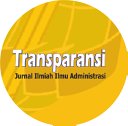Implementasi Kebijakan Perlindungan Anak dan Perempuan Korban Kekerasan pada Masa Pandemi Covid-19 di Kota Tangerang Selatan
DOI:
https://doi.org/10.31334/transparansi.v5i2.2431Keywords:
Policy Implementation, Violence of Children and Women, Resources,Abstract
This study aims to determine and analyze the implementation of policies to protect children and women victims of violence during the Covid-19 pandemic in South Tangerang City. This research theory uses the theory of Policy Implementation in the Van Matter Van Horn concept with 6 (six) indicators including Policy Standard and Objectives, Resources, Inter-Organizational Communication, Characteristics of Implementers, Implementor Disposition, Social Environment, Economics and Politics. The research design used qualitative approach with a descriptive method. Methods of data collection by interview, observation and documentation. The results of the research found that the implementation of policies to protect children and women victims of violence has not yet been fully implemented. This is because there are still some findings of problems in policy implementation which include: lack of quantity of human resources, fragmentation originating from pressure from interest groups or from the legislative committee, lack of budget for policy implementation, lack of optimal support from DPRD and even the mayor in implementing child protection and women victims of violence, low commitment of policy implementers. Based on these conclusion points, this study recommends several things which include: increasing the number of staff implementing assistance in the UPTD P2TP2A South Tangerang city by 30-50 people, placing the protection of children and women victims of violence as a policy priority, re-activating social media and websites in order to facilitate socialization to the community as a whole, speed up the mentoring time to 7 days to 1 month, from 6 months to 2 years.References
Andhini, A. S. D., & Arifin, R. (2019). Analisis perlindungan hukum terhadap tindak kekerasan pada anak di Indonesia.
antaranews.com. (2019, July). Banten raih penghargaan pelopor provinsi layak anak. https://www.antaranews.com/berita/973992/banten-raih-penghargaan-pelopor-provinsi-layak-anak
bantennews.co.id. (2022, July 23). Banten Kembali Raih Pelopor Provinsi Layak Anak (Provila). https://www.bantennews.co.id/banten-kembali-raih-pelopor-provinsi-layak-anak-provila/
Bantenprov.go.id. (2019, July 26). Banten Raih Pelopor Provinsi Layak Anak. https://diskominfo.bantenprov.go.id/post/banten-raih-pelopor-provinsi-layak-anak
Colebatch, H. K., & Hoppe, R. (2018). Introduction to the handbook on policy, process and governing. In Handbook on policy, process and governing. Edward Elgar Publishing.
Dror, Y. (2017). Public Policymaking: Reexamined. Routledge.
Dye, T. R. (2013). Understanding public policy. Pearson.
Emmons, K. M., & Chambers, D. A. (2021). Policy implementation science–an unexplored strategy to address social determinants of health. Ethnicity & Disease, 31(1), 133.
Handayani, T. (2018). Perlindungan Dan Penegakan Hukum Terhadap Kasus Kekerasan Seksual Pada Anak. Jurnal Hukum Mimbar Justitia, 2(2), 826–839.
Hayati, F. A., Susanto, S., & Yanto, O. (2021). Urgensi Perlindungan Hukum Atas Hak Anak Dari Aksi Kekerasan Di Kawasan Tangerang Selatan. Prosiding Senantias: Seminar Nasional Hasil Penelitian Dan Pengabdian Kepada Masyarakat, 1(1), 1215–1222.
Hehanussa, D. J. A., & Salamor, Y. B. (2019). Membangun Kesadaran Hukum Perempuan Dan Anak Dalam Penanggulangan Tindak Pidana Kekerasan Seksual. Sabdamas, 1(1), 292–297.
Hidayat, A. (2020). Kekerasan Terhadap Anak dan Perempuan. Schoulid: Indonesian Journal of School Counseling, 5(2), 57–66.
Hidayat, A. (2021). Kekerasan terhadap Anak dan Perempuan. Al-Murabbi: Jurnal Studi Kependidikan Dan Keislaman, 8(1), 22–33.
Kementerian Pemberdayaan Perempuan dan Perlindungan Anak RI. (2022). Data Korban Kekerasan pada Anak dan Perempuan. https://kekerasan.kemenpppa.go.id/ringkasan
Kementerian Sosial. (2018). Buku Pintar Perlindungan Anak. Kementerian Sosial Republik Indonesia.
Liu, H. K. (2017). Exploring online engagement in public policy consultation: The crowd or the few? Australian Journal of Public Administration, 76(1), 33–47.
McConnell, A., & t Hart, P. (2019). Inaction and public policy: understanding why policymakers ‘do nothing.’ Policy Sciences, 52(4), 645–661.
Peraturan Menteri Negara Pemberdayaan Perempuan dan
Perlindungan Anak Nomor 2 Tahun 2010 tentang Rencana Aksi Nasional Pencegahan dan Penanganan Kekerasan Terhadap Anak, Kementerian Negara Pemberdayaan Perempuan dan Perlindungan Anak (2010).
Pemerintah Kota Tangerang Selatan. (2012). Peraturan Daerah Kota Tangerang Selatan Nomor 3 Tahun 2012 tentang Perlindungan Perempuan dan Anak Korban Kekerasan.
Perempuan, K. (2021). Perempuan dalam himpitan pandemi: Lonjakan kekerasan seksual, kekerasan siber, perkawinan anak, dan keterbatasan penanganan ditengah covid-19. Catatan Tahunan.
Praptiningsih, N. A., & Tarmini, W. (2022). Pemberdayaan Relawan dalam Antisipasi Kekerasan pada Perempuan dan Anak. JMM (Jurnal Masyarakat Mandiri), 6(1), 131–140.
Prastio, L. O., Abdillah, A., Nurlia, E., & Tati, T. (2021). Kepemimpinan Perempuan di Pemerintah Daerah: Kajian Kepemimpinan Perempuan Walikota Tangerang Selatan. Journal of Governance and Local Politics (JGLP), 3(2), 103–114.
Purwanti, A., & Hardiyanti, M. (2018). Strategi Penyelesaian Tindak Kekerasan Seksual Terhadap Perempuan dan Anak Melalui RUU Kekerasan Seksual. Masalah-Masalah Hukum, 47(2), 138–148.
Pusat Data dan Informasi Kementerian Kesehatan RI. (2018). Kekerasan Terhadap Anak dan Remaja. Kementerian Kesehatan RI.
Ramadani, M., & Yuliani, F. (2017). Kekerasan dalam rumah tangga (KDRT) sebagai salah satu isu kesehatan masyarakat secara global. Jurnal Kesehatan Masyarakat Andalas, 9(2), 80–87.
Ramadhan, D. F., & Rahman, A. (2022). Implementasi Kebijakan Pengadaan Barang/Jasa Pemerintah melalui E-Procurement pada Layanan Pengadaan Secara Elektronik Kota Depok. Transparansi: Jurnal Ilmiah Ilmu Administrasi, 5(1), 6–18.
Rofiah, N. (2017). Kekerasan dalam rumah tangga dalam perspektif Islam. Wawasan: Jurnal Ilmiah Agama Dan Sosial Budaya, 2(1), 31–44.
Rosnawati, E. (2018). Peran Pusat Pelayanan Terpadu Pemberdayaan Perempuan dan Anak (P2TP2A) dalam mengatasi kekerasan dalam rumah tangga. Kosmik Hukum, 18(1).
Rusyidi, B., & Raharjo, S. T. (2018). Peran pekerja sosial dalam penanganan kekerasan terhadap perempuan dan anak. Sosio Informa: Kajian Permasalahan Sosial Dan Usaha Kesejahteraan Sosial, 4(1).
Santoso, A. B. (2019). Kekerasan Dalam Rumah Tangga (KDRT) Terhadap Perempuan: Perspektif Pekerjaan Sosial. Komunitas, 10(1), 39–57.
Setyaningrum, A., & Arifin, R. (2019). Analisis Upaya Perlindungan dan Pemulihan Terhadap Korban Kekerasan dalam Rumah Tangga (KDRT) Khususnya Anak-Anak dan Perempuan. Jurnal Ilmiah Muqoddimah: Jurnal Ilmu Sosial, Politik Dan Hummanioramaniora, 3(1), 9–19.
Siregar, E., Rakhmawaty, D., & Siregar, Z. A. (2020). Kekerasan Seksual Terhadap Perempuan: Realitas Dan Hukum. PROGRESIF: Jurnal Hukum, 14(1).
Ucuk Suyono, Y. (2019). Perlindungan hukum terhadap anak, korban kekerasan psikologis didalam rumah tangga dari orang tua. Lex Jurnal: Kajian Hukum & Keadilan, 3(01).
van Buuren, A., Lewis, J. M., Peters, B. G., & Voorberg, W. (2020). Improving public policy and administration: exploring the potential of design. Policy & Politics, 48(1), 3–19.
van Meter, D. S., & van Horn, C. E. (1975). The Policy Implementation Process: A Conceptual Framework. Administration & Society, 6(4), 445–488.
Downloads
Published
Issue
Section
License

This work is licensed under a Creative Commons Attribution-ShareAlike 4.0 International License
Please find the rights and licenses in Transparansi : Jurnal Ilmiah Ilmu Administrasi By submitting the article/manuscript of the article, the author(s) agree with this policy. No specific document sign-off is required.
- License
The commercial use of the article will be governed by the Creative Commons Attribution license as currently displayed on Creative Commons Attribution-ShareAlike 4.0 International License.
2. Author(s)' Warranties
The author warrants that the article is original, written by stated author(s), has not been published before, contains no unlawful statements, does not infringe the rights of others, is subject to copyright that is vested exclusively in the author and free of any third party rights, and that any necessary written permissions to quote from other sources have been obtained by the author(s).
3. User Rights
Transparansi : Jurnal Ilmiah Ilmu Administrasi spirit is to disseminate articles published are as free as possible. Under the Creative Commons license, Transparansi : Jurnal Ilmiah Ilmu Administrasi permits users to copy, distribute, display, and perform the work for non-commercial purposes only. Users will also need to attribute authors and Transparansi : Jurnal Ilmiah Ilmu Administrasi on distributing works in the journal and other media of publications.
4. Co-Authorship
If the article was jointly prepared by more than one author, any authors submitting the manuscript warrants that he/she has been authorized by all co-authors to be agreed on this copyright and license notice (agreement) on their behalf, and agrees to inform his/her co-authors of the terms of this policy. Transparansi : Jurnal Ilmiah Ilmu Administrasi will not be held liable for anything that may arise due to the author(s) internal dispute. Transparansi : Jurnal Ilmiah Ilmu Administrasi will only communicate with the corresponding author.
5. Miscellaneous
Transparansi : Jurnal Ilmiah Ilmu Administrasi will publish the article (or have it published) in the journal if the article’s editorial process is successfully completed. Transparansi : Jurnal Ilmiah Ilmu Administrasi editors may modify the article to a style of punctuation, spelling, capitalization, referencing and usage that deems appropriate. The author acknowledges that the article may be published so that it will be publicly accessible and such access will be free of charge for the readers as mentioned in point 3.
Every accepted manuscript should be accompanied by "Copyright Transfer Agreement"prior to the article publication.











